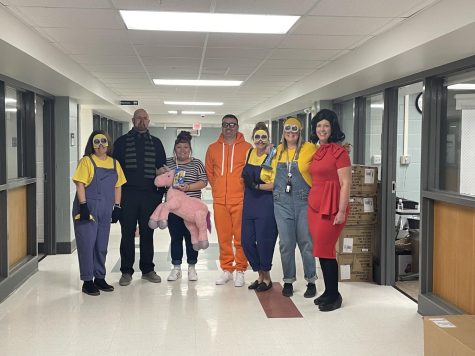Mindsets change in a post-Parkland society
Concerns about school safety are discussed by BHS staff
Schools used to be institutions with the sole purpose of educating young minds. Now, their main concern is keeping children alive.
At least 193 primary, elementary, and high schools faced active gun violence since the Columbine high school massacre in 1999. With the increase in nationwide attacks, schools are exploring changes in safety.
“The [idea of school violence] is just sad. I mean, when I was growing up, going to school we never had to worry about anything,” said principal Jeremie Sirois. “We’d show up, we’d come and go as we please–there were hunters that I went to school with that had racks in their trucks, so you never really worried about [being shot].”
Today’s social climate is hostile due to current events, which drives worry into a lot of students, especially junior Alyssa Landry.
“[It’s] scary,” said Landry. “I never expected my younger brother to come home like, ‘what do I do if someone pulls a fire alarm when it’s a shooting?’”
With recent events in mind, administration and the police department have altered their previous response to these emergencies.
“A fire alarm is going to be followed up with a specific announcement, and at that point everybody will have a little bit more direction in regards to what they should be doing and what they shouldn’t be doing,” school resource officer Paul Rondeau said.
The most effective way to prevent fear of this happening is by following the guidelines that the school has created, such as with the science doors.
“I totally get that nobody wants to walk all the way to the front door,” said science teacher Denise Ryan. “But I don’t want any student to be the one that lets the wrong person in and have to live with that.”
Ryan’s classroom is located near the problematic doors, so she deals with students who break the rule of letting in others. English teacher Dawn Pendergrass witnessed a similar situation regarding the doors.
“[A student I was escorting and I] were passing by the science doors and he noticed that there were two seniors trying to get in,” said Pendergrass. “He immediately opened those doors even though I was standing there.”
The two seniors complained, but followed Pendergrass’s instructions to go through the main doors. She explained that the student did not know the seniors. This incident happened the day before the Parkland massacre.
After witnessing students repetitively allowing other people–including strangers–in through locked doors, Rondeau expressed his concern for the school’s security.
“There’s a reason for that [rule]: so that we can recognize who’s coming into the building,” Rondeau said.
Throughout the school-year, administration has sent out reminders on the school website warning students to avoid opening any locked entrances–specifically the science doors.
“What we don’t want to do is let in a threat unknowingly to create a situation,” Rondeau said.
As part of procedure in the case of a lock-down, students that are in the bathrooms or hallways who can’t enter a locked classroom know to remain in or find a bathroom to protect themselves.
“The school needs to fix the bathroom locks,” said junior Matthew Tardif. “There are always people who will abuse it, but it’s safer than being in an unlocked room with an active threat roaming the halls.”
Sirois stated that the doors cannot lock because staff and students must have access to them.
“It would be real easy for someone to go in, lock the door and stay in there for however long, shutting down bathrooms for God knows how many kids,” Sirois said.
If a student were to lock themselves inside the bathroom, employees in the school have keys that would unlock the bathroom doors from the outside. Many have wondered if the keys could lead to a change in the bathroom policy.
“[Changing the locks] would cost some [money], but possibly,” said Sirois. “We’ve got a big budget [and] we allocate it as we can.”
According to Sirois, there has been no discussion on changing the bathroom locks or glass of the classroom doors with the district safety consultant.
“I think that [for] anybody who wants to do harm to someone–especially with the glass in the window–[it] would be fairly easy to get in the room if they wanted to,” social studies teacher Brian Curit said.
According to a New York Times article, Out of Tragedy, a Protective Glass for Schools, written by Claire Martin, companies such as School Guard Glass have created lightweight, bulletproof glass. It “functions more like the bulletproof glass found in banks and other high-security buildings than the tempered glass that’s commonly used in car windows.”
“The LTI Group and Kapiloff’s Glass sell such setups for $50,000 or more apiece– a price that’s prohibitively expensive for most schools,” Martin states.
Christopher Kapiloff and Jeff Besse, the co-founder of the LTI Group, established School Guard Glass in 2013.
“The price per door, including installation, is about $1,000 to $1,200,” said Martin. “The glass is lightweight enough that it can be used to replace glass in existing doors and window panes.”
Landry, as well as other students have questions about what to do if they are in certain parts of the building in the case of an oncoming threat, such as the cafeteria.
“We need to start having those conversations [for] when you’re in the cafeteria, you’re in the study hall, or you’re in a part of the building where you don’t know what the policy is for what you’re supposed to do in a lock down,” Landry said.
According to the resource officer, there is a safety protocol in the case of a lock-down in the cafeteria. However, for security reasons, the plan is not public.
“I can only count literally less than a handful of times where [the threats] were perceived as serious issues,” said Rondeau. “I’m happy to say all of them [have been resolved].”
All of the drills by the school and the police department are done to “get everybody on the same page.”
“More than likely, if it’s a deadly situation, my job is to take that threat out. And I will do that without hesitation,” said Rondeau. “I wouldn’t be able to go home knowing that I didn’t do 110% of what I should’ve done.”
Mathematics teacher Charlie Chaponis asserted that his duties as a father and as a husband have to come before his job as a teacher.
“One of the hardest parts is feeling like these students are actually your kids as opposed to just students,” said Chaponis. “That makes it even harder to back away from a situation and try and keep yourself safe, as opposed to doing everything you possibly could–whether it was safe for you or not.”
Teachers have become more aware of the dangers involved with their jobs. Ryan stated that she has taught at Biddeford “for 31 years, [which is] pre-Columbine, [where they] never even thought twice about kids coming in and out of the building.”
“We [the teachers] have to be guidance counselors, support systems, moms, babysitters, psychologists, and now we have to potentially be a hero,” Pendergrass said.
Rondeau explains that despite a large amount of training and planning, nobody can plan for the possible “what-ifs.”
“I can tell you what my primary function is, and as cruel as this may sound, my job is to eliminate the threat,” said Rondeau. “And that’s what I fully intend to do.”








